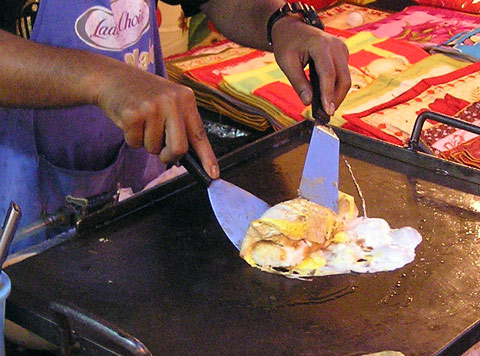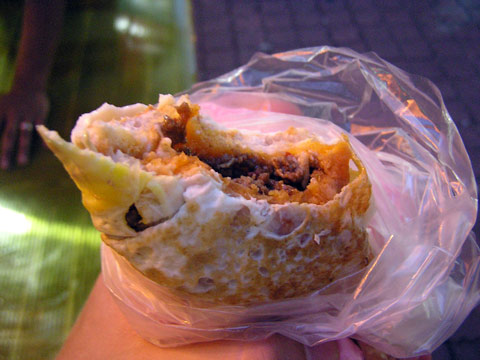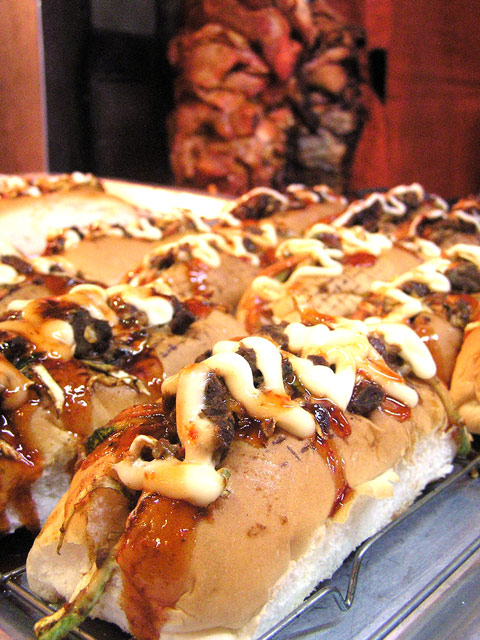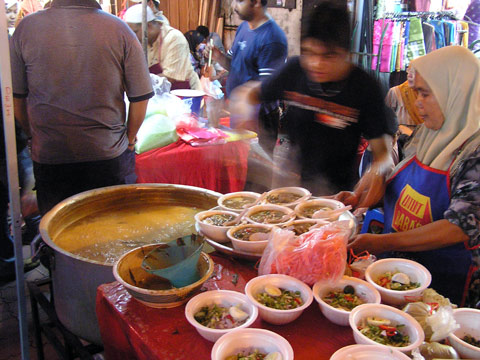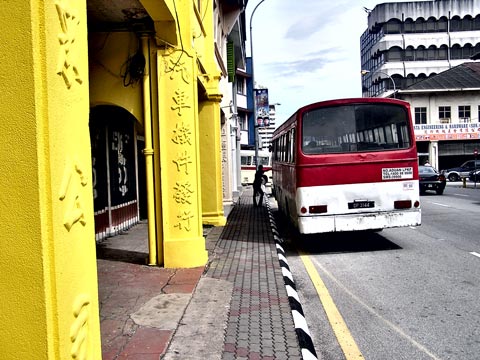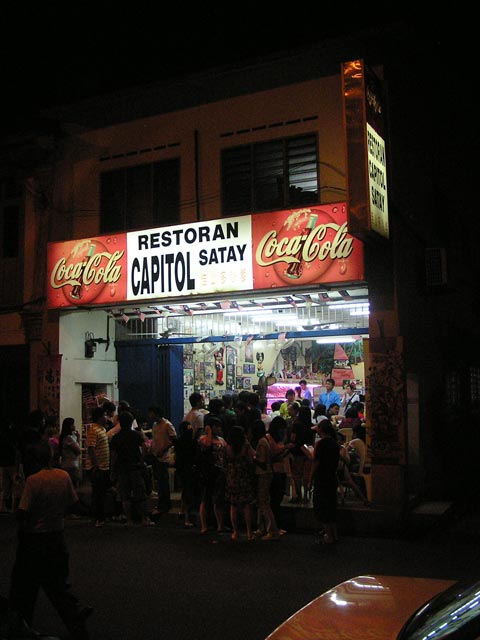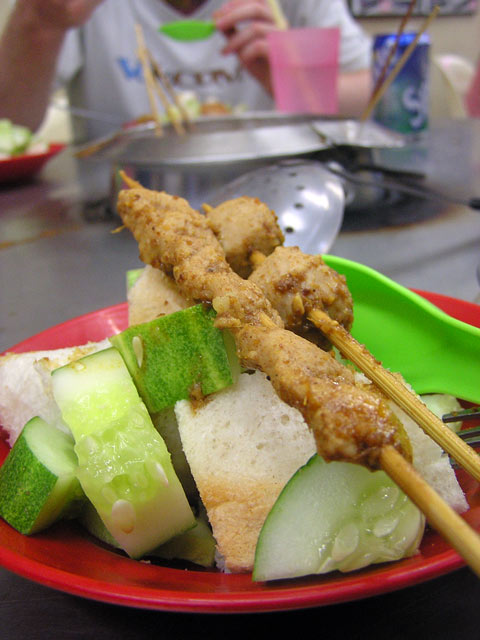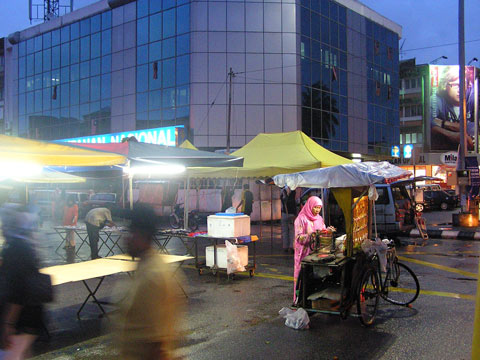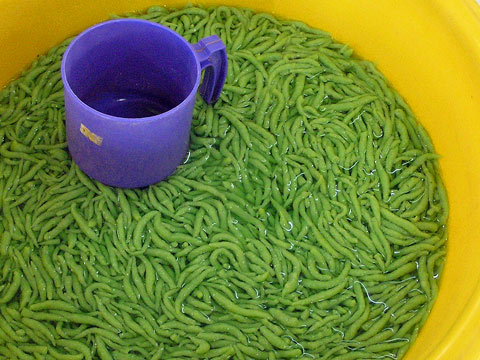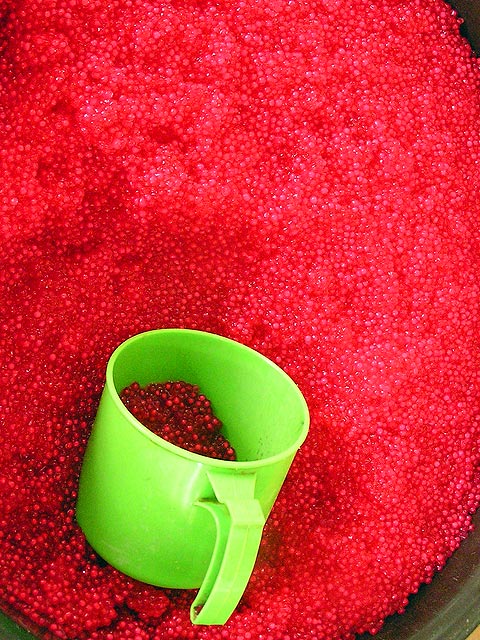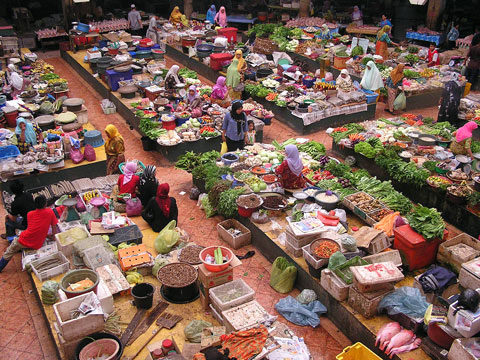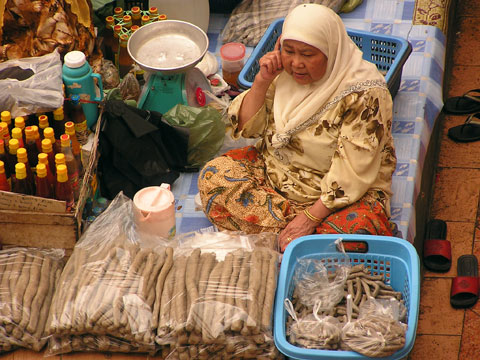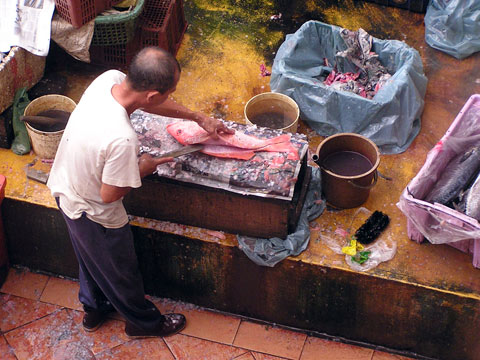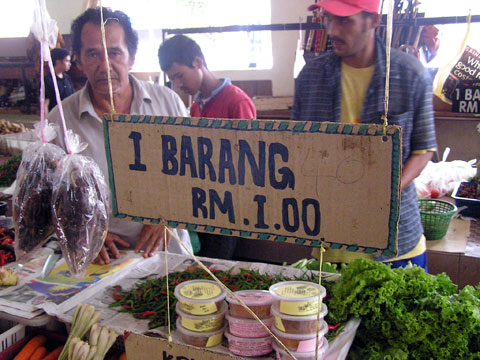
The falling price of the barang, Kota Bharu, Malaysia
Continue reading
Post Category → Malaysia
Great balls of chicken rice
The apparent simplicity of Hainanese chicken rice is what makes it an addictive comfort food. It looks like simple steamed chicken and with fatty, chicken stock-cooked rice but is so fecund in people’s memories at it is impossible to begin to judge it. There are objectively bad plates of chicken rice replete with ropy strands of fowl; dry, stock-free rice and the umami-punch of MSG. What makes the perfect plate is harder to define. Certainly, moistness and tastiness of the bird plays a part, but can it be too moist? Some come served with a bonus small bowl of thin stock. Is this essential and should it be judged separately?
Each region puts its own twist on the recipe. The above plate is Melaka’s version, served with golf-ball shaped spheres of rice. Some places serve the chicken over rice, others present the components on separate plates. It is important to eat both some rice and some chicken in each mouthful, but when do you eat the thin bowl of stock that comes alongside the plate? I tend to eat it Cambodian-style, dipping a spoonful of rice into it, which in Malaysia, probably makes me look cretinous.
See also: Robyn and Dave at EatingAsia seek out the origins of chicken ball rice.
For chicken rice with balls: Hoe Kee, Jalan Hang Jebat (Jonker Walk), Melaka (Malacca), Malaysia.
The last ditch

Saturday night market in Little India, Kuala Lumpur
If you could choose your last meal in a country, what would it be?
It’s a much more concrete question than some imagined last supper: unless you’re on death row or about to commit suicide then chances are you’ll have no power over the menu for your last meal, making it a question barely worth mooting as often as it is mooted. Most people who are executed don’t get any choice (contrary to the American myth) and being on your death bed also tends not to elevate the appetite. What the “last supper” question is really asking is “what is the best that you’ve already eaten?” from which the questioner is meant to discern the palate of the questioned or at least receive an answer pre-fried in nostalgia.
As for a last meal in Malaysia, what I’d do is bury myself neck-deep in a crowd and eat whatever the locals are chowing down upon, preferably in an open air environment.
Which is what I did.
The Saturday night market in Kuala Lumpur’s Little India could not be more packed without the crowd trampling each other to death ensuring that some in their midst had died whilst consuming their last meal. The food draws ecumenically from Malaysia’s street food faiths making it a great destination to either bone up on your knowledge of regional specialties or revisit the greatest hits of your time in Malaysia. There is also a great deal of street food that seems to be of questionable provenance, by far the most dangerous of meals.
Witness roti tarbus, a spicy Sloppy Joe made from a sweet white bun stuffed with minced, chilli-infused meat and wrapped entirely in a thin layer of fried egg.
Once again, Asia seems to be at the forefront of perfecting variations on American classics. The mix of chilli and fried egg is one of the world’s great flavour combinations in a one handed food.
Roti kebab is kebab meat fresh from the rotating pole, served up in a sweet bun topped with a squirt of commercial mayonnaise and a dose of barbecue sauce. Saccharine and squishy.
Fried chicken gets the stringy-looking outer coating from shreds of galangal, that lesser, woodier cousin of ginger; and is served in Styrofoam clamshells to be eaten elsewhere.
On the more traditional front, this stall is among the handful of street vendors outside of Penang to be serving Penang-style assam laksa, doling out both bowls and thin plastic bags. This version was tartly sour and thin but judging from the crowd and the near impossibility of procuring a seat on the communal tables behind the stall, this is the way that Kuala Lumpurites like it.
With a full stomach, I left Malaysia on the bus to Singapore, then onto Tiger Airways redeye to Melbourne, Australia via Darwin.
After almost three years, I’m home and it’s weird.
Catching a bus in central Ipoh
Satay and fondue, together at last
I never tire of regional novelties like cooking a skewer of something in a boiling pot of satay sauce, which constitutes something of a specialty in Melaka (Malacca), Malaysia and is the raison d’etre of Capitol Satay. This style of satay, satay celup, was (as far as I can find) invented by the owners of Capitol Satay in the 1950s and continues to be a reason for Kuala Lumpurites to drive down to Melaka to eat a morsel on a stick.
Capitol Satay on Lorong Bukit China is packed with satay-boiling punters from the moment it opens around 5:30pm until whatever ungodly hour that it closes. Pick from a random and wide array of skewered components from their refrigerator, ranging from meats to quail eggs to tofu and wontons, take a seat and wait for a roiling pot of peanut sauce to arrive at your table and present you with a new opportunity to burn yourself on a rich and sticky fluid.
The result: not as tasty as it is downright fun. The flavours of your chosen components barely make a dent in the satay sauce’s nuttiness, and conversely, very few of the components (apart from bread and tofu) soak up much sauce. I’m still positive that I lost a wonton in the sauce’s simmering brown depths never to be seen again.
Location:Capitol Satay Celup, 41, Lorong Bukit China, Melaka (Malacca), Malaysia
Kota Bharu Street Life
Cendol and pearls
These green worms are cendol (pronounced chen-dul), made from green pea flour flavoured with pandan leaves. They’re essential for making the dish that is their eponym: a combination of the worms, shaved ice, santan (the first extraction of coconut milk), gula (palm sugar) and often red beans. With a dish so simple, the only key is finding a vendor who uses top quality ingredients.
The same vendor selling the cendol had (what I’m guessing are) tapioca pearls, dyed red. From a distance I thought that they were pomegranate arils, but on closer inspection, they clearly were not.
Any suggestions?
See Also: The Star Online provides a recipe for cendol.
Kota Bharu’s Central Market
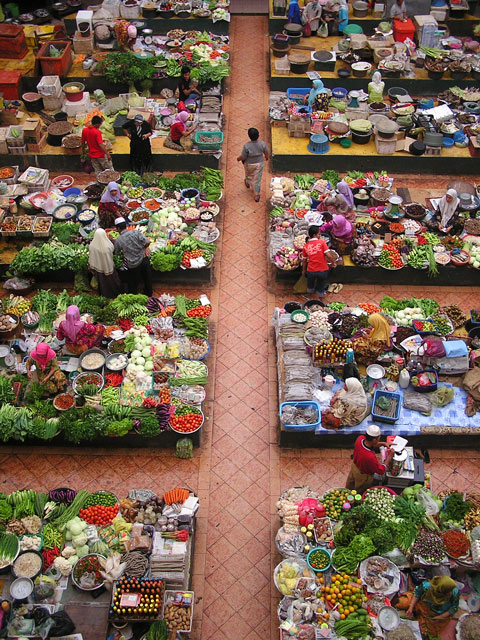
The central octagonal hall of Kota Bharu’s central market (Pasar Siti Khadijah) opens up like a cathedral devoted to the veneration of fresh Malaysian produce. A skylight illuminates the scene in a dull sepia glow throughout the day; upper levels providing a birds-eye view of the myriad proceedings below. By the crowded standard of Malaysia’s wet markets, Kota Bharu market has an overwhelming sense of austerity in comparison.
A while ago EatingAsia rhetorically asked whether you’d consider moving for a wet market, and for this one, I probably would. I ended up lingering for a few extra days in Kota Bharu just for the food, dropping by the market’s outstanding food hall for my curry fix. I had expected that Penang would be the sort of place that I could settle in, but not this northeastern corner of peninsular Malaysia. Maybe I could overlook the Kelantan state’s dominant but declining political party toying with the idea of hudud law. Maybe I could dismiss the concomitant lack of a brewery.
The ground floor plays host to primarily vegetable sellers on raised platforms with meats confined to the darker outer rim.
Keropok lekor, grey tubes of fish paste and starch, are probably one of the world’s least attractive foods in their pre-fried form. These snakes of sticky paste are sliced diagonally and then deep fried; giving a little crispness on the outer edges and chewiness to the centre. The flavour (in this case) is unrelenting fish.
I am always impressed by the effortlessness and economy by which people can clean a fish with a meat cleaver without destroying it. Any time I’ve tried it myself, I end up reverting back to a more flexible knife to peel out the chunks of fillet that I’ve missed entirely. The above method involved cutting the fish along the fillet on each side, then cleaving the head cleanly in two, so that the buyer received exactly half a fish, sans-innards.
See also:To Market, to market event at A Scientist in the Kitchen

